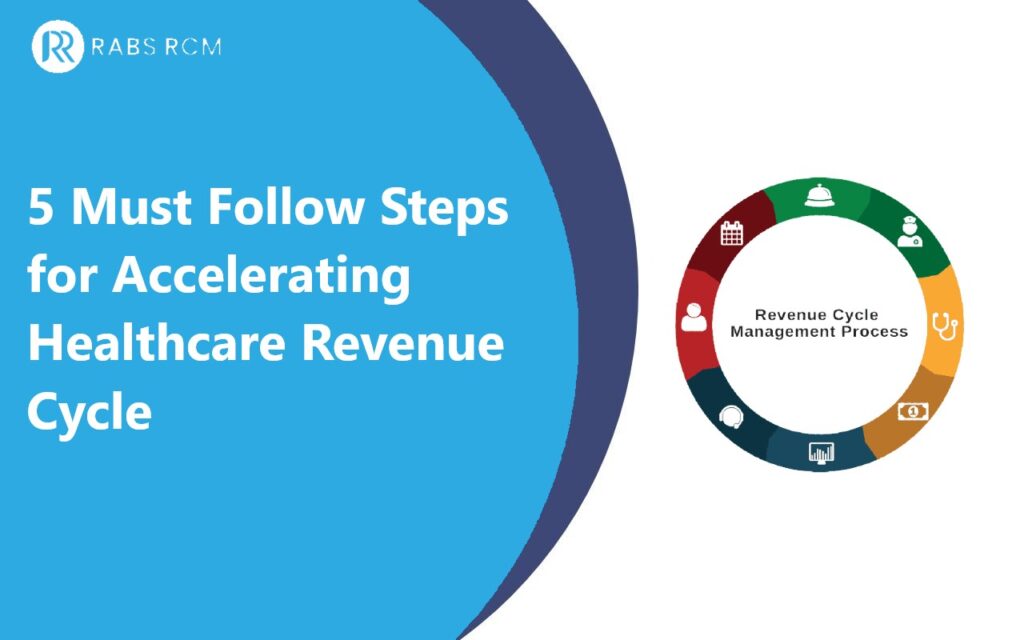Copyright © 2022 Rabs-RCM. All Rights Reserved.

5 Must Follow Steps for Accelerating Healthcare Revenue Cycle
In the complex landscape of healthcare management, optimizing revenue cycles is paramount to ensuring financial stability and efficiency within medical facilities. Healthcare revenue cycles encompass managing patient financial information, from initial registration to final payment collection. By streamlining and accelerating this cycle, healthcare providers can enhance cash flow, reduce administrative burden, and improve patient satisfaction.
Here are five essential steps to accelerate the healthcare revenue cycle:
Step 1: Enhance Patient Registration Process
Efficient patient registration lays the foundation for a smooth revenue cycle. Simplifying and digitizing the registration process can significantly reduce errors and delays. Implementing electronic health record (EHR) systems and patient portals allows for seamless data collection and verification. By leveraging these technologies, healthcare facilities can gather accurate patient information swiftly, minimizing registration time and improving data accuracy.
Step 2: Improve Coding and Documentation Accuracy
Accurate medical coding and documentation are crucial for maximizing revenue and preventing claim denials. Healthcare providers must invest in ongoing staff training to ensure compliance with coding guidelines and regulations. Additionally, adopting advanced documentation software equipped with coding assistance features can aid in maintaining accuracy and completeness in patient records, ultimately expediting the billing process.
Step 3: Optimize Claims Submission Process
Submitting clean claims is essential for accelerating revenue cycles. Healthcare organizations should minimize errors and discrepancies before claims are sent to payers. Automated claims scrubbing tools can help identify and rectify potential issues before submission, reducing the likelihood of rejections or delays. Providers can expedite reimbursement and improve cash flow by streamlining the claims submission process.
Step 4: Expedite Claims Adjudication
Timely claims adjudication is critical for maintaining a steady revenue stream. Healthcare providers should actively monitor the status of submitted claims and promptly address any discrepancies or denials. Implementing robust denial management protocols and leveraging technology-driven solutions can expedite the resolution of claim issues, ensuring prompt reimbursement and minimizing revenue loss.
Step 5: Streamline Patient Payment Collections
Facilitating prompt and convenient patient payments is essential for optimizing revenue cycles. Multiple payment options, such as online portals, payment plans, and automated reminders, can enhance patient satisfaction and accelerate revenue collection. Healthcare facilities should also prioritize transparent billing practices and proactive communication to address patient concerns and minimize payment delays.
Conclusion
Efficient healthcare revenue cycle management is essential for sustaining financial viability and delivering quality patient care. Healthcare providers can streamline processes, minimize errors, and accelerate revenue collection by following these five crucial steps. Investing in technology, staff training, and patient engagement strategies can yield significant improvements in revenue cycle performance, ultimately benefiting providers and patients.

- Our seamless and streamlined efforts, experience, as well as commitment to our clients, all come together to provide both you and your patients with a remarkable experience to remember.
Contact Us
- 2612 62nd St NW Rochester MN 55901 (USA)
- (507) 262-4566
- info@rabs-rcm.com

